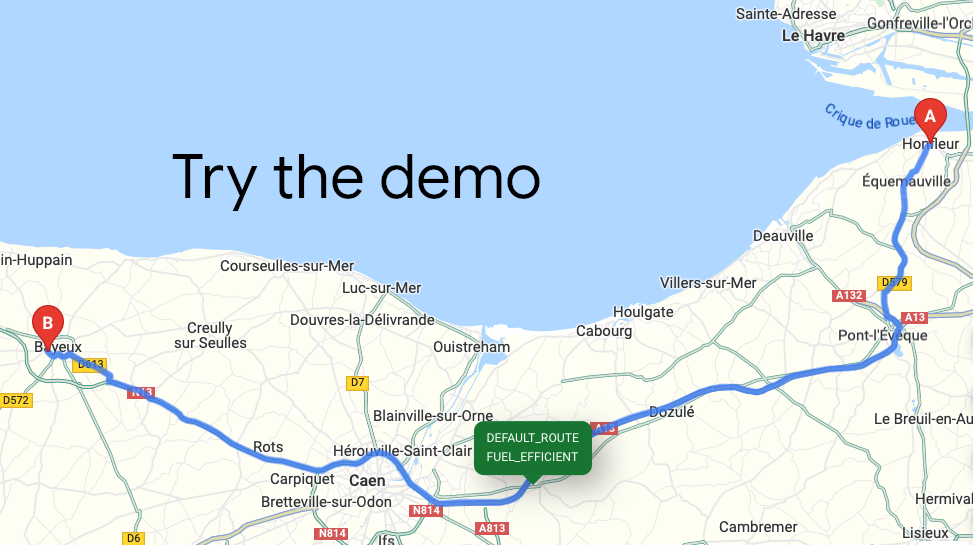परिचय
Compute Routes, Routes API सेवा में उपलब्ध एक तरीका है. यह एचटीटीपीएस अनुरोध स्वीकार करता है और दो जगहों के बीच सबसे सही रास्ता दिखाता है. अलग-अलग जगहों पर साइकल, मोटरसाइकल, कार, बस, मेट्रो वगैरह से या पैदल जाने के लिए, रीयल-टाइम ट्रैफ़िक के साथ रास्ते की जानकारी पाने की सुविधा दें.
क्या आपको रूट मैट्रिक्स चाहिए? अगर आपको रूट मैट्रिक्स में दिलचस्पी है, तो Compute Route Matrix की खास जानकारी देखें.
क्या माइग्रेट किया जा रहा है? अगर आपको Distance Matrix API (लेगसी) से माइग्रेट करना है, तो माइग्रेशन के निर्देश देखें. ये निर्देश Routes API पर क्यों माइग्रेट करें से शुरू होते हैं.
Compute Routes का इस्तेमाल क्यों करें
Compute Routes की मदद से, रास्ते की ज़्यादा जानकारी मिलती है. इससे लागत और क्वालिटी को ऑप्टिमाइज़ करते हुए, अपनी पसंद के हिसाब से वाहनों या पैकेज को रूट किया जा सकता है.
Compute Routes की मदद से क्या-क्या किया जा सकता है?
Routes API Compute Routes तरीके से, ये काम किए जा सकते हैं:
यात्रा के अलग-अलग तरीकों के लिए निर्देश पाएं. साथ ही, एक या एक से ज़्यादा डेस्टिनेशन के लिए निर्देश पाएं:
यात्रा के साधन: बस, मेट्रो वगैरह, कार, दोपहिया वाहन, पैदल चलना या साइकल चलाना.
रास्ते में पड़ने वाली जगहों की एक सीरीज़, जिसे सबसे कम समय में तय करने के लिए ऑप्टिमाइज़ किया जा सकता है.
मूल जगह, मंज़िल, और रास्ते में रुकने की जगहों के बारे में बताने के लिए, एक से ज़्यादा तरीकों का इस्तेमाल करें:
टेक्स्ट स्ट्रिंग. उदाहरण के लिए: "Chicago, IL", "Darwin, NT, Australia", "1800 Amphitheatre Parkway, Mountain View, CA 94043" या "CWF6+FWX Mountain View, California"
जगह के आईडी
अक्षांश और देशांतर के कोऑर्डिनेट. साथ ही, वाहन की दिशा की जानकारी भी दी जा सकती है
अपनी ज़रूरतों और लक्ष्यों के हिसाब से, रास्ते के विकल्पों में बदलाव करें:
अपने वाहन के इंजन के हिसाब से, ईंधन या ऊर्जा की कम खपत वाले रास्ते चुनें: डीज़ल, इलेक्ट्रिक, हाइब्रिड, पेट्रोल. ज़्यादा जानकारी के लिए, ईको-फ़्रेंडली रास्ते का विकल्प पाना लेख पढ़ें.
ट्रैफ़िक का हिसाब लगाने के लिए, ज़्यादा सटीक विकल्प सेट करें. इससे आपको क्वालिटी और लेटेन्सी के बीच समझौता करने से जुड़े फ़ैसले लेने में मदद मिलती है. ज़्यादा जानकारी के लिए, यह तय करना कि ट्रैफ़िक डेटा को कैसे और कब शामिल करना है लेख पढ़ें.
रास्ते के पॉइंट के लिए, वाहन की दिशा और सड़क के किनारे की जानकारी सेट करें, ताकि पहुंचने में लगने वाले अनुमानित समय (ईटीए) की जानकारी ज़्यादा सटीक हो. ज़्यादा जानकारी के लिए, वाहन की दिशा और सड़क का किनारा तय करना लेख पढ़ें.
पास-थ्रू वर्सेस टर्मिनल लोकेशन और सुरक्षित स्टॉपओवर लोकेशन के बारे में बताएं. ज़्यादा जानकारी के लिए, रास्ते में कोई स्टॉप सेट करना और रास्ते में कोई पॉइंट सेट करना लेख पढ़ें.
रास्ते की दूरी और पहुंचने का अनुमानित समय (ईटीए) के साथ-साथ, टोल की जानकारी का अनुरोध करें. ज़्यादा जानकारी के लिए, किसी रास्ते के लिए टोल का हिसाब लगाना लेख पढ़ें.
फ़ील्ड मास्क का इस्तेमाल करके, सिर्फ़ ज़रूरी डेटा का अनुरोध करें. इससे लेटेंसी और क्वालिटी को कंट्रोल किया जा सकता है. इससे, प्रोसेसिंग में लगने वाले बेवजह समय और अनुरोध के लिए ज़्यादा बिलिंग रेट से बचा जा सकता है. ज़्यादा जानकारी के लिए, यह चुनें कि कौनसी जानकारी वापस लानी है लेख पढ़ें.
Compute Routes API कैसे काम करता है
Routes API का ComputeRoutes तरीका, एचटीटीपी पोस्ट अनुरोध स्वीकार करता है. इसमें JSON फ़ॉर्मैट में अनुरोध का मुख्य हिस्सा होता है. इसमें अनुरोध की जानकारी शामिल होती है. इसके लिए, मूल जगह, मंज़िल, travelMode, और फ़ील्ड मास्क की जानकारी देना ज़रूरी है. इससे यह तय किया जा सकेगा कि किन फ़ील्ड की जानकारी वापस लानी है.
उदाहरण
curl -X POST -d '{ "origin": { "address": "1800 Amphitheatre Parkway, Mountain View, CA 94043" }, "destination": { "address": "Sloat Blvd &, Upper Great Hwy, San Francisco, CA 94132" }, "travelMode": "DRIVE" }' \ -H 'Content-Type: application/json' -H 'X-Goog-Api-Key: YOUR_API_KEY' \ -H 'X-Goog-FieldMask: routes.duration,routes.distanceMeters' \ 'https://routes.googleapis.com/directions/v2:computeRoutes'
इसके बाद, सेवा अनुरोध किए गए रास्ते का हिसाब लगाती है और आपके अनुरोध किए गए फ़ील्ड दिखाती है.
संसाधन
यहां दी गई टेबल में, Routes API की Compute Routes तरीके से उपलब्ध संसाधनों की खास जानकारी दी गई है. साथ ही, यह भी बताया गया है कि इससे कौनसा डेटा मिलता है.
| डेटा संसाधन | डेटा वापस लाया गया | जवाब का फ़ॉर्मैट |
|---|---|---|
| ComputeRoutes | यह किसी रूट के लिए रास्ते, लेग, और चरणों की जानकारी देता है. साथ ही, अनुरोध किए जाने पर वैकल्पिक रास्तों की जानकारी भी देता है. | JSON |
Compute Routes का इस्तेमाल कैसे करें
| 1 | सेट अप करना | सबसे पहले, Google Cloud प्रोजेक्ट सेट अप करें और इसके बाद, सेट अप करने के निर्देशों का पालन करें. |
| 2 | Routes API के बिलिंग सिस्टम के बारे में जानकारी | जानकारी के लिए, इस्तेमाल और बिलिंग लेख पढ़ें. |
| 3 | रास्ता ढूंढना और जवाब की समीक्षा करना | ज़्यादा जानकारी के लिए, रास्ता पाना और रास्ते के रिस्पॉन्स की समीक्षा करना लेख पढ़ें. |
उपलब्ध क्लाइंट लाइब्रेरी
Compute Routes के लिए उपलब्ध क्लाइंट लाइब्रेरी की सूची देखने के लिए, क्लाइंट लाइब्रेरी देखें.
आगे क्या करना है
- रास्ते की जानकारी पाना
- रास्ते के उपलब्ध विकल्प
- चुनें कि कौनसी जानकारी वापस लानी है
- Directions API (लेगसी) से माइग्रेट करना
- Routes API की झलक देखने की सुविधा से GA पर माइग्रेट करना


